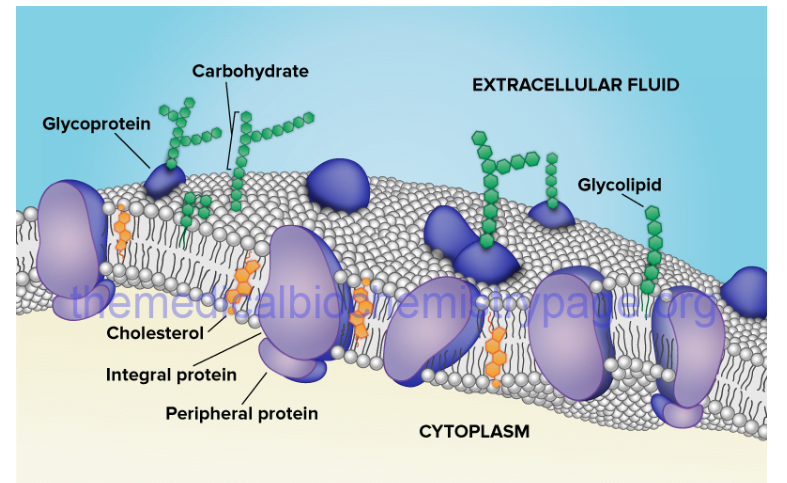The biological membrane forms a cell and separates the interior of the cell from the external environment by means of a semi-permeable membrane.
- The selective permeability of the biological membrane refers that different molecule diffuse and passes by the active or passive transport system.
Structure and composition of Biological Membrane

(Source: https://themedicalbiochemistrypage.org/biological-membranes-and-membrane-transport-processes/ )
- The biological membrane consists of a phospholipid bilayer that divides the intracellular and extracellular components and is composed of lipid, protein, and carbohydrate that exists in a fluid state.
- The outer layer is the plasma membrane while the internal membrane making a compartment is cell organelles.
- The composition of the lipid bilayer is the two-layer of amphipathic phospholipids of the intracellular hydrophobic tail and the extracellular faces of the hydrophilic head.
- Other lipids like glycolipids, sterols, cholesterol are also included in the biological membrane.
- A phospholipid is a glycerol and phosphate group linked with two fatty acids while glycolipid contains a glucose head in phospholipid.
- Sterols are present in plants and cholesterol in animals while bacterial membranes do not contain these components.
- Three different proteins are found in biomembrane: Integral proteins, periphery proteins, and lipid-bound proteins.
- Carbohydrate binds with the lipid or protein as they account for less than 10% and are the third major component in the plasma membrane.
- Carbohydrate comprises of 2 to 60 monosaccharide units of sugar chains either in straight or branched form.
Functions of Biological membrane
- Biomembrane controls the composition of the interior of the cells from the external environment by means of selective permeability.
- The selective permeability allows the gradient of ions to flow across them by sending and receiving signals in the form of chemical and electrical and also enables to generate energy.
- Phospholipids serve as a cell structural component and function as an energy storehouse.
- Integral proteins carry out molecule transportation while periphery proteins are linked to the peripheral proteins or lipids as they remain outside the membrane and lipid-bound proteins transport the nutrients, ions, and molecules and are also involved in extracellular signal reception.
- Carbohydrates on the surface of the cell function as a point of attachment and adhesion of the exterior molecules and forms a structural role as a physical barrier.
Membrane transport processes
Membrane proteins are involved in active and passive transport system where the nutrient molecules enter into the cell and toxic molecules are transported out of the cell.
The movement of the solutes are mediated by the membrane transport protein where a specific transport protein binds to a specific cell type which is differentiated by the differential transcription of the genes coding for each proteins.
Two main types of membrane transport processes are:
1. Passive transport
- Simple diffusion
- Facilitated diffusion
- Osmosis
2. Active transport
- Primary active transport
- Secondary active transport

Passive transport
- Passive transport system do not require energy but the movement of molecules are by a concentration gradient, hydrophobicity, size and charge of the molecules.
- It means that in this process molecules move from higher concentration to lower concentration.
Three types of passive transport processes are:
Simple diffusion is a random movement of small molecules along with a concentration gradient through a semipermeable membrane. Water, oxygen, carbon dioxide, ethanol and urea passes easily.
Facilitated diffusion is the movement and diffusion of large molecules like ions and sucrose through a transport protein. The glucose and amino acids are transported from the bloodstream and diffuses into the cell.
Osmosis is dependent on solute concentration where the movement of water molecules is from high concentration to low concentration through a selectively permeable membrane. Osmosis mainly occurs in large intestine where the foods processed are passed from stomach to small intestine and nutrient gets absorbed in large intestine via osmosis.
Active transport
- Active transport system is against the concentration gradient and requires cellular energy for the movement of molecules which moves from the region of lower concentration to higher concentration.
- It maintains the balance concentrations of ions and molecules in the cell.
Active transport process are of mainly two types:
Primary active transport uses ATP as a chemical energy to move across the biological membrane. In animal cells, sodium – potassium pump is an important mechanism to balance the ions in the body. The transport process utilizes ATP as an energy source to pump Na+ out of the cell and K+ inside the cell.
Other primary active transport includes use of light energy in plant cell during photosynthesis where proteins are involved to create a photon gradient across the membrane and also creates the reduction power of NADPH.
Secondary active transport uses the stored energy of electrochemical gradients to move the molecule against their concentration gradient. It is called secondary transport because the energy is not directly used i.e, there is no direct coupling of ATP and only depends upon the electrochemical potential difference formed by the pumping of ions.
In secondary active transport system, when two molecules are transported in the same direction, the transport protein is called a symporter and if two molecules move in anti – direction, then it is called antiporter.

Involvement of membranes in health and disease
- From non – functional ion channels , serious disease like Cystic fibrosis is caused from the mutation in the CFTR gene. It lacks the transport of Cl– ions out of the cell and produced thick dehydrated mucus and results in breathing difficulty and chest infections.
- Tetanus neurotoxin and botulinum neurotoxin enters to the cell via endocytosis and blocks the neurotransmission resulting in prolonged skeletal muscle contraction.
- Membrane proteins have made possible in designing effective drugs due to its structural and functional knowledge. Pore forming proteins are used as a drug in the treatment of influenza virus infection.
Learn more:
References:
- https://www.ncbi.nlm.nih.gov/pmc/articles/PMC4626904/
- https://www.wikilectures.eu/w/Biological_membrane
- https://www.annualreviews.org/doi/pdf/10.1146/annurev-biophys-121219-081637
- https://www.researchgate.net/publication/283449135_Biological_membranes
- https://themedicalbiochemistrypage.org/biological-membranes-and-membrane-transport-processes/
- https://www.britannica.com/science/membrane-biology
- https://ib.bioninja.com.au/standard-level/topic-1-cell-biology/14-membrane-transport/types-of-transport.html
- https://www.khanacademy.org/science/ap-biology/cell-structure-and-function/facilitated-diffusion/a/active-transport